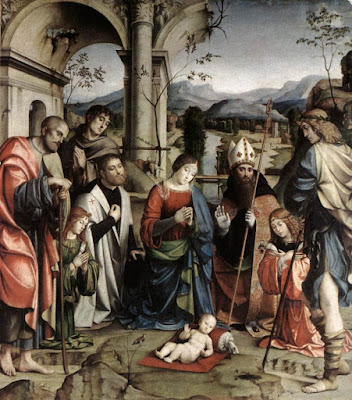Edward Hutton's art sympathies were with the pre-Raphaelites, as evidenced by his appraisal of Raphael's St. Cecilia. Below are highlights from his tour of Bologna's Accademia and Museo Civico.
Of the school of Bologna, the school painting that is native to the city…there can be nothing to say, for until very late times there was no tradition of art peculiar to Bologna, which for the most part leant almost entirely upon Ferrara…We therefore learn without surprise that in the second half of the fifteenth century the Ferrarese Francesco Costa established himself here in Bologna and was followed in 1483 by his countryman Lorenzo Costa. It was from them that the first Bolognese painter to show any sign of genius learnt his art. This man was Francesco di Maria Raibolini, whom all the world knows as Francia. ...
Bologna is rich in his work, the Accademia possessing no less than nine of his works… the too refined and eclectic art of Francia cannot recompense us for the fact that the unself-conscious art of the fourteenth century and early fifteenth century is not to be had in Bologna.
 |
| Raphael: St. Cecilia |
Through Timoteo Viti, who was, after Giovanni Santi Raphael’s first master, we reach Raphael, by whom there is here the famous S. Cecilia, from the church of S. Giovanni in Monto, where it adorned the altar dedicated in honour of Beata Cecilia Duglioli. There, as we know, S. Cecilia stands in the midst, a small organ reversed in her hands, her eyes lifted to heaven, her own music quite put out by the songs she heard of the angels. About her stand S. John, S. Augustine, and S. Paul and S. Mary Magdalen. The picture has suffered greatly, and we are not sure how much of it was even due to Raphael himself, and this, I suppose, must excuse our disappointment in it. Indeed we turn from it with a real eagerness to that Madonna and Child in Glory with S. Michael, S. John, S. Catherine, and S. Apollonia by Perugino which hangs in this same room, and curiously enough was painted for the same church, but in 1498, whereas Raphael’s picture is, I think, of 1516….
 |
| Perugino |
The excellent Museo Civico is not so disappointing as the Academia, for it does not promise so much. It contains too, what I should suppose is one of the finest collections of Etruscan antiquities in existence, but, for me it holds but two things of real delight, I mean the two reliefs of Jacopo della Quercia, the first a relief of the Birth of the Virgin in Sala xv, the other a relief of the Madonna and child in Sala xvi. For these in their beauty no words are good enough, nor may one ever really forget them.
 |
| Jacopo della Quercia |
###
Edward Hutton: The Cities of Romagna and the Marches, NY, 1925. Pp. 86-88.

No comments:
Post a Comment